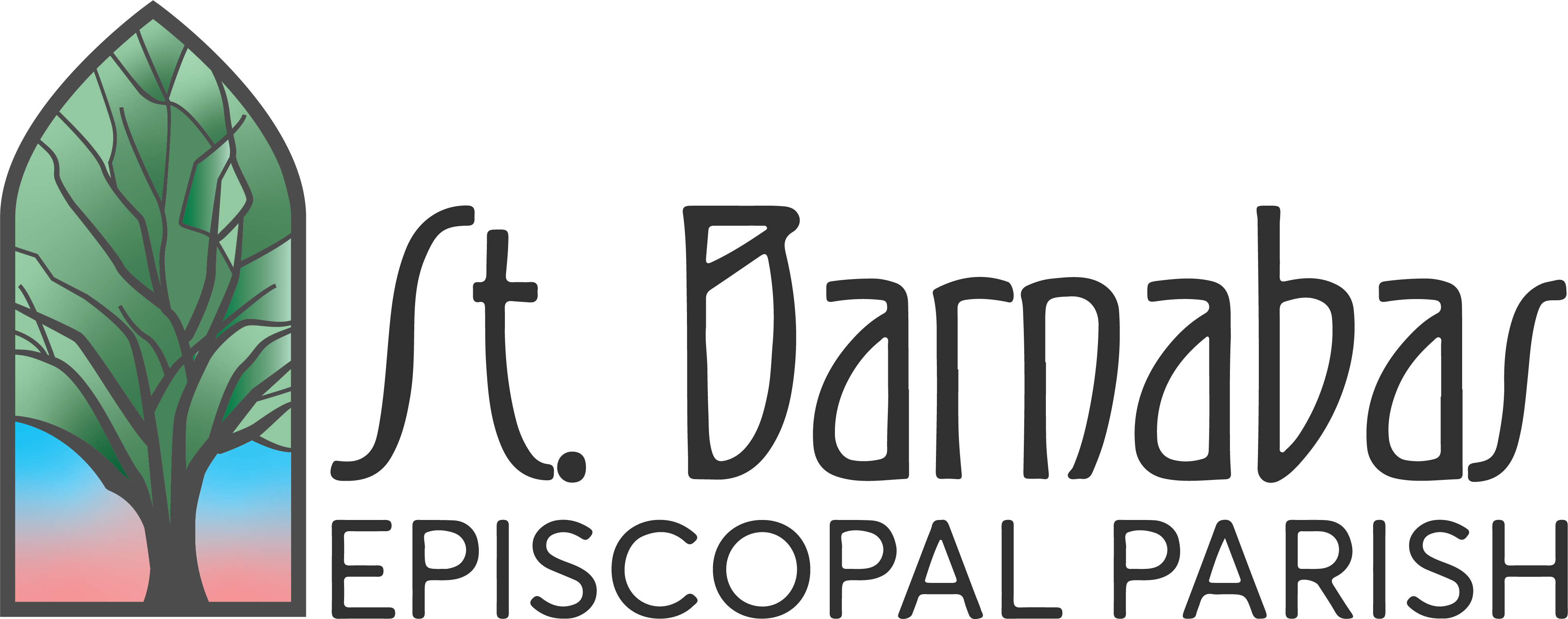Our History

Our Patron, St. Barnabas the Apostle
The Apostles awarded the surname “Barnabas” (“son of encouragement”) to a Levite of Cypriot origin called Joseph. As a young man, Barnabas converted to Christianity shortly after Pentecost (about CE 30), sold his property, and gave the proceeds to the Church. At the Council of Jerusalem (CE 47 to 51) Barnabas and Paul successfully defended the Gentiles’ admission to Christianity, receiving a hearty commendation for their work among people in distant lands.
St. Barnabas the Apostle exemplifies the spirit and mission of our church—welcoming, friendly, generous, and thoughtful. Like our namesake who welcomed the Gentiles, the St. Barnabas community welcomes all people, honoring their ethnic, cultural, and religious backgrounds and the ways they live out their unique identities. In the tradition of the Apostle Barnabas, we offer an encouraging, supportive, and collaborative community. The parish celebrates the life of St. Barnabas on the Sunday nearest June 11, the Feast of St. Barnabas.
Our Heritage, 1890-Present - 125 Years of Worship, Service, and Gratitude
The First Half-Century (1890 – 1940)
St. Barnabas began as Christ Church Mission in a rented storefront at Colfax Avenue and Josephine Street in 1890. The cornerstone of the present church was laid June 13, 1891. Bishop John Franklin Spalding conducted the opening service on September 6, 1891. An active, energetic, and enthusiastic laity and dynamic leadership from its Rectors have defined St. Barnabas Parish ever since.
The first Rector, Father Charles H. Marshall, expanded the sanctuary, added the parish house (now named Lukens Wing), and planted the elm tree and the garden. In his twenty-five years, he created the Altar Guild, Women’s Guild, and Ladies Auxiliary, beginning a legacy of leadership among the women of St. Barnabas, which continues to this day. Christ Church became St. Barnabas in 1895.
St. Barnabas continued to grow and thrive under the leadership of laity and the parish’s second Rector, Father Charles H. Brady, who served from 1920-1946. Father Brady’s service to St. Barnabas is significant for the establishment of the church school, a Boy Scout troop, and the Guilds of St. Elisabeth and St. Mary.
The Second Half-Century (1941 – 1990)
From 1946 to 1969 the congregation flourished under the pastoral care of Father Alexander Lukens, Sr. The parish house was enlarged and property adjacent to the church, which housed a livery stable, was purchased for the construction of Marshall House, the parish social hall. When Father Brady’s son, John, perished in World War II, the Brady family donated the fireplace in the Brady Room, an alcove of Marshall House. Parishioners helped to found two significant Denver institutions: Spalding Rehabilitation Hospital, serving patients with strokes, brain injuries and complex orthopedic problems, and Sewall Child Development Center, specializing in diagnosis and treatment of children with birth defects and developmental delays.
In the 1960’s, St. Barnabas formed the 1280 Corporation, to help low-income families purchase renovated, affordable homes. Women in the parish were instrumental in starting Denver’s first chapter of Planned Parenthood.
In the 1970’s and 1980’s, under Father Gilbert E. Dahlberg, parishioners created a community pre-school in the church, volunteered with a group trying to ease the conflicts of forced busing, and participated in a city-wide effort to help Cambodian refugees relocate to Denver.
In September 1984, St. Barnabas welcomed The Reverend Edward F. Ostertag as its Rector. “Father O,” as he was affectionately called, was characterized as a man who forthrightly expressed principles of equality and fairness. He was a sensitive, strong spokesperson for various cultures and diversity, and the person who helped characterize St. Barnabas as a parish that can reach the unreachable. He provided a temporary home for the Living Waters Native American Congregation and strengthened the foundation for St. Barnabas to become a community that welcomes people of many different life styles.
During Father O’s pastorate, a large roof beam crashed to the sanctuary floor. Fortunately, no one was injured. Upon further examination, structural weaknesses were also found in two walls and the basement, making repair a very major undertaking. The rallying spirit of St. Barnabas showed itself when, with the support of Bishop Frey and the unflinching resolve of Father O and the people of St. Barnabas, we creatively found the resources needed to rebuild. Parishioners served as project manager and architect. The Finance Committee used their skills to arrange financing through bonds.
Adaptability became a hallmark of the parish during the two years of construction. We had the experience of gathering around an altar and facing one another in Lukens Wing, so there was continuity in the transition to the new sanctuary. All but the north and south walls of the sanctuary were torn down and rebuilt. The sanctuary was dramatically redesigned as a place of worship with a central altar and seating around three sides of the altar, instead of a traditional long nave with the people separated from the altar by a screen. The sanctuary was painted with bright colors. The people of St. Mark’s Episcopal Church, a downtown parish in the process of closure, donated the beautiful marble altar that is the centerpiece of the sanctuary. In 1990, St. Barnabas welcomed St. Mark’s congregation to use our facilities for their services. As time went on, some of them became members of St. Barnabas and brought their loving spirit with them.
The Second Century (1991 – present)
The Reverend Albert N. Halverstadt succeeded Father Ostertag as Rector in 1991 and presided over St. Barnabas’ centennial celebration and move into the new sanctuary. Father Al, as he preferred to be called, was impressed by the spirit of our vibrant, growing, welcoming congregation and our prayerful thankfulness for and pride in our achievements. He wonderfully complemented and enhanced the spirit of St. Barnabas, strongly promoting diversity and encouraging pursuit of the social message of the gospels. Under Father Al’s leadership and collaboration with parishioners, outreach programs that benefit the entire community were developed. Of special note is Project Angel Heart, which began in St. Barnabas’ kitchen, cooking and delivering meals to people suffering from HIV/AIDS. It now has its own facility and serves meals to thousands of clients in metropolitan Denver.
Membership drawn from many sources grew 40%, and the budget increased 80%. To help meet our increasing needs, in 1996 St. Barnabas called The Reverend Georgia L. Humphrey to join us as Associate Rector.
Upon Father Al’s retirement, Associate Rector Georgia Humphrey was installed as Rector in 2000. “Georgia” continued the informality of being on a first-name basis with the congregation. She enthusiastically continued to encourage lay leadership in all aspects of parish life and worship. In 2001, she wisely hired a lay Family Minister to serve the growing population of families with young children. The Family Minister inaugurated a Parents of Young Children group, with seven families and ten children under age 10. At present, the group consists of 37 families, many of them non-traditional, and 60 children. As the parish grew the Rev. Deb Angell was called as Associate Rector to broaden the pastoral ministry of the parish. A concern for social justice drove both Rector and laity and cemented our reputation as one of the most progressive parishes in the Diocese, an identity to which we are fully committed.
Following Georgia’s retirement in 2006 the parish was led by Interim Rector Sandra Boyd and Associate Rector Debra Angell. The interim period was alternately an exciting time of exploration of the life of the parish and a time of tense uncertainty. With the leadership of Rev. Deb, whose mantra was "Stay Calm and Carry On", the longstanding values of the parish were reasserted: to Faithfully follow Christ on the path he leads and to faithfully, pastorally and prophetically serve the diverse community in which we are placed.
In 2008 the Reverend Paul Garrett was called as the eighth Rector of St. Barnabas. This period has been characterized by growth in the Family Ministry program and an exciting outward focus and engagement with our community. We have partnered with the Colfax Community Network to reach out to homeless families living in motels along the Colfax Ave. corridor. We also are a host site one night a week for a small shelter for homeless women. Fr. Paul led the congregation through a revisit of much of the in-depth work conducted by the parish in the early 1990’s on issues of human sexuality and the full inclusion in the life of the church and parish of members of the LGBT community. As a result of this period of both historical and current self-study the parish has been authorized to once again conduct blessing of commitment for same sex couples! (The first gay union blessing in the Diocese was performed at St. Barnabas.) The parish is also committed to working with other religious groups through the Interfaith Alliance of Colorado to help move civil society to a place of full civil rights for members of the LGBT community.
In 2015 St Barnabas embarked on a journey to renew our buildings. We've remodeled our parish hall, including classrooms, office and work space and our kitchen. We've also opened the space between our Sanctuary and Fellowship Hall to accommodate a growing congregation. Following a successful Capital Campaign, architects and a contractor were chosen and hired, and our congregation moved temporarily to nearby Warren United Methodist Church. This time of pilgrimage granted our parish time and space to renew our legacy both in the space our ministries call home and in our commitment to who we are as a community called to faithful service in Christ's name. We celebrated the return to our iconic building at 13th and Vine St. on November 13, 2016.
In 2019, after a difficult transitional period, The Reverend Dr. Jeffrey Nelson was called as Priest-in-Charge assisted by Ms. Patti Walter, Pastoral Associate. Under Fr. Jeffrey’s leadership, the parish began the process of envisioning a future as a smaller, urban congregation with a focus on a theologically progressive faith and a heart for outreach toward and advocacy on behalf of marginalized and dispossessed peoples. Through a deliberate process of congregational reflection on its past and present realities, and looking toward an exciting future, the congregation developed its current vision and mission statements and supporting pillars to help guide the congregation into the 21st century.
In May of 2021, Fr. Jeffrey was called to serve as the ninth Rector of St. Barnabas Episcopal Parish

